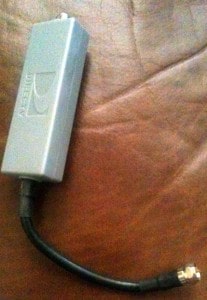Following up the DirecTV service call that I blogged about this morning, there was some clear, obvious waste that could have been avoided through better training. It makes you wonder how many billions of dollars are wasted across the country each year because companies under-invest in training and because they can't connect the pieces of their organization.
I was having trouble with one TV after having to take some thing apart – after recabling everything, it didn't work. I thought I was careful in putting it back together the way it had been (I had even gotten out my 5S labeler to mark pieces). When I called if the phone agent had been able to give me correct info, DirecTV could have avoided a costly (to them, it was free to me) in-home tech appointment. It was completely avoidable.
On Friday, I had called DirecTV to get help and was told, leaving the acronyms and jargon out of it:
- Connect the wall to widget A
- Connect widget A to doodad B
- Connect doodad B to the receiver
Nothing worked, so they scheduled a service call. This would have been FAR more inconvenient if I hadn't been working from home, so I'm lucky there.
 The tech arrived (as I had confirmed via phone) and came inside. He removed widget A from the equation and everything instantly worked fine. It took him all of 30 seconds. He pointed at widget A (pictured at left) and said “you don't need that anymore.”
The tech arrived (as I had confirmed via phone) and came inside. He removed widget A from the equation and everything instantly worked fine. It took him all of 30 seconds. He pointed at widget A (pictured at left) and said “you don't need that anymore.”
I asked him why the phone agent had told me the wrong instructions and the tech sniffed, “Well they're just phone support, they never know anything.”
DirecTV had made some recent changes to their hardware to allow whole-home DVR networking (hence the installation of doodad B last week). But the original service tech had left widget A there, even though it wasn't needed. Eve with my anal-retentiveness, I managed to put it back together wrong.
Why is it that, it seems, the biggest companies are the worst at investing in training and in communicating change to their employees? That lack of training (and overcomplexity of their product?) squarely cost DirecTV money and hurts their bottom line.
But, I suspect the training budget for the call center is in Silo A and the cost of in-home techs is Silo B. The CEO and shareholders should be upset about the lack of coordination and the systemic waste in their overall process.
Siloed thinking. Short-term budget thinking… customers and shareholders suffer. Middle managers prosper, I assume. Go figure.
Final thought – it's not just big corporations. How often do hospitals put in new software and then underinvest in training (REALLY training) staff how to use it? How often is there a process change, yet people aren't properly informed?
Please scroll down (or click) to post a comment. Connect with me on LinkedIn.
Let’s work together to build a culture of continuous improvement and psychological safety. If you're a leader looking to create lasting change—not just projects—I help organizations:
- Engage people at all levels in sustainable improvement
- Shift from fear of mistakes to learning from them
- Apply Lean thinking in practical, people-centered ways
Interested in coaching or a keynote talk? Let’s start a conversation.










[…] back this afternoon for a somewhat related Part 2 to this tale. […]
Mark,
I believe you experienced two things:
1. As far as I know, DirecTV’s field service techs are independent contractors. They are scheduled by DirecTV, but they don’t work for DirecTV, so yes, there are silos. I’m sure it’s “cheaper” for them to be arranged this way (outsourced field service).
2. You saw the benefit of going to the gemba. The person on the phone could not see your systems’ configuration, the tech who was there could. All that the DirecTV person (phone) can see from where they are is your box models and serial numbers and they have some notes on what rooms they are in. They have no idea if the boxes are connected to the internet, to a phone line or how your network may or may not be configured. So technically the tech was right, the phone service people “don’t know anything” about the physical configuration of your particular system.
If you’ve ever tried to coach someone through using a DVR or some new application on their computer for the first time over the phone, you will appreciate the dilemma that the phone service person was in. If you had the ability to show them what you had with a webcam, I would think it likely that they could have solved your problem as quickly as the field service tech did.
Steve – DirecTV has a mix of contractors and employees. I can’t find the reference, but I thought I had read that they were shifting the balance to more direct employees instead of contractors, for quality reasons.
Going to my “gemba” (my home) was certainly more expensive than DirecTV. The phone agent had incorrect information, simple as that. That can be addressed. This was an issue about connecting one receiver to the wall — the phone agent confidently told me I needed two intermediate devices, the in-home rep was correct that I only needed one.
I’m not suggesting they can address all of the most complex situations over the phone… but they could have done this simple case over the phone. Even if I had texted a picture to the phone agent, she had incorrect information and would have given me the same incorrect advice. It’s not that she had incorrect information about MY situation, she just wasn’t trained well, it seems.
Thanks for reading and for your comment!
My previous job before being a Lean consultant was helping customer service have the diagnositic tools and knowledge prior to new product or upgrade release.
Many times customer service would get a tech service call for something and the poor rep was like “WHAT product and WHO are you Mr/Mrs Customer?”
I worked directly with the product developers and product managers prior to get this info and training set up for customer support. What amazed me was how often some felt as though the product would have no defects and therefore the customer would never need to call for support! Some thought customer service’s request was asking too much.
Long story short, a lot of organizations do not think of the impact their changes will have on customer support which happens to be where clients call the most!
This post really resonates with me. However, for our internal, large organization it’s less about silos and siloed budgets and more about the lack of organizational prioritization of well managed, internal training and incorporating change management (short-term budget thinking). Our middle managers don’t benefit; they pull their hair out trying to figure out how to bring their employees to fluency or even mastery (there is some evidence of silos in their individual attempts).
In regards to training and adoption of healthcare systems, I enjoyed the concepts and methodologies espoused in Breakaway by Charles Fred, and Beyond Implementation by Drs. Haugen and Woodside.
Thanks, Trevor. I didn’t mean to imply life goes swimmingly for middle managers in that sort of system, but if they hit their local silo budget in the short-term, they “win” in a way.
I just had a similar situation. I started cable service in NY with Time Warner Cable. They sent a tech over to hook me up, and he installed one of their wireless routers. I asked him if I could use mine, and he said no. Then I asked him if I could change the network name and (17 character!) password, and he said no — I had to use TWC equipment.
This sounded fishy to me, so after he left, I called tech support and they confirmed what I suspected: I could use my router with my network name and password.
The cost to TWC? extra installation time by the service rep; 15 minutes on the phone with tech support; 5 minutes with the customer service rep in their office when I returned the router and cables the next day; restocking cost for their equipment.